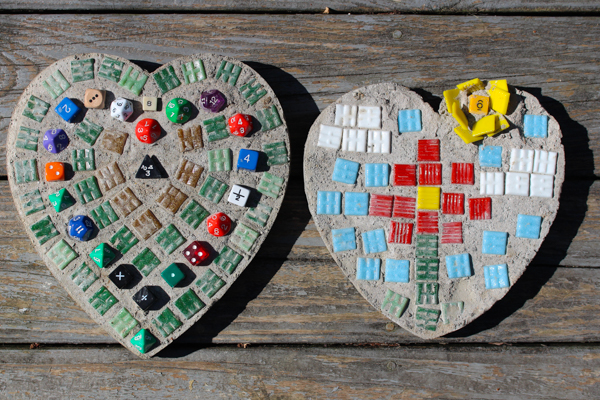Insert sad emoji here!
Time to tell the truth: I DO love myself a good cement project. I love making mosaic stepping stones with broken dishes as the tesserae, and concrete planters using old plastic cups as molds, and this week my teenager and I are in the process of making cement pumpkins, tying them up in some more of her sister’s torn tights.
I tell myself that cement is a natural product, which it is.
But what I’ve tried not to tell myself is that the manufacturing process for making cement at its current large scale is highly toxic. It’s one of the worst things happening to the environment at the moment.
What is Portland Cement?
Here’s what the EPA has to say about Portland cement and its manufacturing process:
- Portland cement manufacturing is an energy‐intensive process that grinds and heats a mixture of raw materials such as limestone, clay, sand and iron ore in a rotary kiln. That product, called clinker, is cooled, ground and then mixed with a small amount of gypsum to produce cement.
- A variety of pollutants are emitted from the burning of fuels and heating of raw materials. Emissions also can occur from grinding, cooling and materials‐handling steps in the manufacturing process.
LImestone, clay, sand, iron, and gypsum are all natural materials. If using natural materials instead of petroleum byproducts is your main goal, then Portland cement is a workable solution.
The manufacture of cement wasn’t always environmentally bad, either. Cement was manufactured and used by the Ancient Romans without emitting air pollutants. It’s the current methods and scale of manufacture that make Portland cement so toxic today.
How is Portland Cement Made?
Smithsonian Magazine explains the process: “The recipe for making cement calls for heating the limestone, which requires fossil fuels. And when heated, limestone sends carbon dioxide gas wafting into the atmosphere, where it traps heat, contributing to global warming.” It’s primarily the usage of limestone, which is primarily calcium carbonate, that causes this extreme off-gassing of carbon. But the manufacture and processing of the materials required to create the heat source also have a negative environmental impact.
Multiply that by all the major industrial consumers of cement world-wide, and you have a serious world-wide problem. Here’s what this MIT thesis has to say about the results of this large-scale process of manufacturing cement:
“[C]ement manufacturing produces 3-8% of global CO 2 emissions (World Resources Institute, 1995; World Business Council of Sustainable Development, 2002; ATHENA SMI, 1999 cited in Chaturvedi, 2004; Mehta, 1998). Moreover, the cement industry is highly energy-intensive. In 2000, cement consumed three times more energy than steel on a per dollar output basis 2 (EIA, 2002). For the same year, at least 16 million metric tons (Mt) of water was used in cement manufacturing alone-not including the water required for raw materials extraction and cement hydration in concrete plants.” [bolding is mine]
Obviously, this is less the fault of my concrete planters and cement pumpkins than it is the world’s supply of parking lots, buildings, and roads. This Chatham House report states both that “on a ‘business as usual’ trajectory, global cement production is set to increase to over 5 billion tonnes a year over the next 30 years,” AND that “to bring the cement sector in line with the Paris Agreement on climate change, its annual emissions will need to fall by at least 16 per cent by 2030.”
I probably don’t even need to tell you this, but the cement sector’s emissions do NOT look like they’ll be falling in line with the Paris Agreement by 2030. It’s probably time to boycott even my minimal bag-a-year Portland cement habit.
What is the Alternative?
Building and infrastructure industries do have numerous viable and lower-impact alternatives to concrete, but products like ashcrete and post-consumer waste aren’t exactly going to show up in my cute garden stepping stones.
Instead, DIYers like myself can consider the following possible alternatives:
- plaster of Paris. Plaster of Paris, so-called because that’s where it was originally created, is primarily made of gypsum. It, too, requires resources to heat it, but doesn’t off-gas carbon in the way that cement does. Plaster of Paris is very DIY-friendly. You can use it for many of the decorative objects that you’d otherwise make from cement.
- clay. Clay, as a natural resource, is the most eco-friendly alternative. You can use air-dry clay to make decorative objects, but if you fire and glaze and fire again, your clay object will be waterproof and quite sturdy. Pottery studios often offer classes and open studio hours so you can use their equipment to make the clay pots and pumpkins of your dreams.
Not gonna lie–I AM probably going to go ahead and make my cement pumpkins. My teenager is all revved up about it and if you know a teenager, then you know that getting them revved up about something not horrible can be rare and precious and must not be wasted. However, in the future I am going to be a LOT more thoughtful about when and where I use cement. For instance, kiln-fired clay pots seem like an obvious alternative to those DIY concrete planters that I’m so fond of.
Please let me know all your cement alternatives for mosaic stepping stones!









